Turkey
 From the modern and bustling Istanbul to the ancient ruins of Ephesus, Turkey has so much to offer. Expect great value as well, since Turkey’s currency Lira, provides more purchasing power than the Euro and the dollar.
From the modern and bustling Istanbul to the ancient ruins of Ephesus, Turkey has so much to offer. Expect great value as well, since Turkey’s currency Lira, provides more purchasing power than the Euro and the dollar.
Tour Istanbul, once known as Constantinople and the capital of the Byzantine and Ottoman empires. Visit the Blue Mosque, Hagia Sohpia, Topkapi Palace, stroll through the Pera District and cruise the Bosphorus.
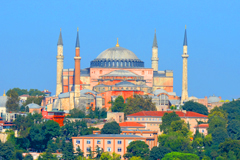 Istanbul – Hagia Sohpia
Istanbul – Hagia Sohpia
Visit the awe inspiring Hagia Sophia, and then the nearby Basilica Cistern, which Emperor Justinian I built in the sixth century to expand on the previous cistern built by Constantine the Great. Nearby is the Hippodrome, which during Roman times held horse races, gladiator contests and parades.
 Istanbul – Blue Mosque
Istanbul – Blue Mosque
Explore the Blue Mosque, with it vast interior and spacious courtyard. Nearby is the Topkapi Palace, which was once the center of Ottoman government and is now a vast museum.
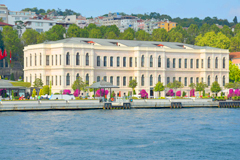 Istanbul – Bosphorus River
Istanbul – Bosphorus River
Take a cruise on the river that divides Europe and Asia. Stunning homes and buildings line the shore.
This is also a busy shipping route as Istanbul continues it’s history as a major hub of international trade.
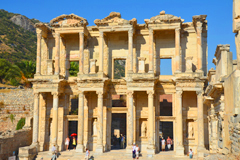 Kusadasi – Ephesus
Kusadasi – Ephesus
This ancient Greek and Roman city, offers some of the world’s most magnificent ruins including the Library of Celsus and the Grand Theater.
Featured Tour
Highlights of Turkey
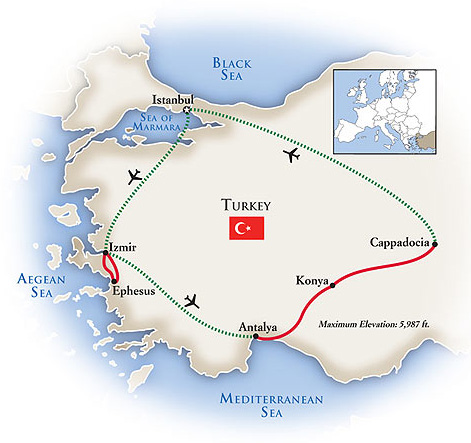
Turkey is a land of contrasts, blending east and west as Europe meets Asia. In sophisticated Istanbul visit Hagia Sophia, the Blue Mosque and Topkapi Palace. Then venture to ancient Ephesus bringing the Greeks and Romans into focus. In Cappadocia explore the fanciful rock formations called the fairy chimneys have tales to tell about both ancient days and today. Glimpse modern daily life in the Grand Bazaar and the Spice Bazaar, and imagine it when surrounded by ruins of shops dating back to the Romans and beyond. Gain insights into the mysticism of the Whirling Dervishes and learn to make Turkish Delights.
Day 1: Welcome to Istanbul
Day 2: Tour Hagia Sofia & Blue Mosque 
Begin your discovery of Istanbul with a walk through the Hippodrome and into history. Famous for its massive dome, considered by many to be the epitome of Byzantine architecture and said to have changed the history of architecture, Hagia Sophia was once the largest cathedral in the world for over 1,000 years, subsequently served as the primary mosque of Constantinople for over 500 years and is now a museum. Located in front of Hagia Sofia, the Blue Mosque, built in 1609 to out-do its neighbor, is regarded as a prime example of Turkish Islamic architecture; its six slender minarets and cascading domes dominate the city skyline. Discover the tens-of-thousands of blue tiles from which it gets its name.
Day 3: Topkapi Palace & Bosphorus Cruise
Step back into the lives of the Ottoman sultans who occupied it for 400 years when you visit Topkapi Palace. Imagine what it was like to live here as you explore the Council Chamber, the Imperial Kitchens and the Harem. Then, enter another world in the Grand Bazaar, the largest covered market in the world, a maze of lanes and alleys in which shoppers can find virtually anything they might be looking for at the over 4,000 shops. Board a boat and cruise across the Bosphorus to the private home of an artist and businessman for a tour and insights on life in Istanbul today. Dine at restaurant on the Bosphorus known for its seafood this evening.
Day 4: Istanbul to Izmir 
After a morning flight to Izmir, visit Sardis, once one of the most important cities in the Persian Empire, home to many ruins from different time periods. Discover what were shops and the mammoth gymnasium dating from the second century AD as you explore the city. Visit the Temple of Artemis, once the fourth-largest Ionic temple in the world, built by the Greeks in honor of the goddess of the hunt. Ancient Sardis also had a large and prosperous Jewish community, which built the largest ancient synagogue outside of ancient Palestine that you’ll explore today. It was also in Sardis that coins were used for the first time.
Day 5: Ephesus
Having seen the Harem in Istanbul, where the women of the sultans’ households lived, gain insights about the role of women in contemporary Turkey this morning before heading off to Ephesus, an ancient bastion of women’s rights and the site of the largest temple built to honor Artemis. Once an important trade center as well as a religious center of early Christianity, the ruins at Ephesus are among the best preserved in the region. As you walk the 2,000-year-old marble and cobblestone streets, it isn’t hard to imagine what the city was like when tradition says that Paul was preaching to the Ephesians, perhaps in the Great Theater that could seat 24,000; dating from the 1st century AD, it is still used today for public theatre and musical performances. Explore the two-story Library of Celsus, the Scholastic Baths, the Arcadian Way and more.
Day 6: Antalya 
Arrive in the “resort capital” of the Turkish Mediterranean coast, Antalya, after a short flight from Istanbul. Visit the ruins of the Roman city of Perge. Pass through the unusual Hellenistic-Roman towers to an impressive colonnaded street line once lined with shops and statues that you’ll see tomorrow at the Antalya Museum.
Day 7: Antalya Archaeology
History and culture through the ages unfold at the Antalya Archeological Museum, one of the largest museums in Turkey with 13 exhibition halls showcasing art and artifacts of the area large and small from the Stone Age onward. Perhaps most impressive are the larger-than-life statues of 16 gods and goddesses as well as emperors and empresses found in Perge and Aspendos in the “Hall of the Gods.” Explore the narrow streets of Antalya’s historic Old Town. This evening, attend a cooking demonstration featuring Turkish coffee as well as Turkish delight, a sweet treat on Turkey tours.
Day 8: Konya & Catal Huyuk
A scenic drive through the mountains leads to Konya, final resting place of the Sufi poet Jelaleddin Rumi, considered by some to be one of the great spiritual teachers and thinkers the world has known, who founded the Whirling Dervishes over 800 years ago. While visiting the Mevlana complex, view his mausoleum, learn about the man and the mystical religious order he founded and see the oldest surviving copies of his work, dating back to the 13th century. Discover Catal Huyuk, built about 6.500 BC and thought to be one of the world’s first towns. A guided tour reveals the ongoing archaeological work being done and what has been learned about the people who abandoned the hunter-gatherer lifestyle and formed a pueblo-style community here so long ago from the artifacts that have been found.
Day 9: Cappadocia 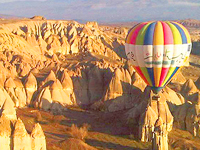
Along the Silk Road, “caravanserais” traditionally provided stopping places for travelers in need of rest and refreshment and were spaced to accommodate a one-day camel trek. We’ll make a rest stop at one this morning, just as people have been doing for centuries. After lunch in Cappadocia, you’ll be invited into the modern home that a family has burrowed into the side of a bluff, just as their ancestors did, before walking along the bluff itself to view the famous “fairy chimneys” for which Cappadocia is known. As early as the days of the Hittites, locals created underground cities to protect them from assorted conquerors who invaded the area. Explore Kaymakli, originally an eight-story underground city that provided safety and refuge for up to 5,000 people; four stories are open to the public. Your home for the next two nights features comfortable cave suites constructed within five different cave formations that are a part of Cappadocia’s historical structure, and each one is unique.
Day 10: Whirling Dervish 
Drifting over the fairy chimneys of the Göreme Valley in a hot air balloon is a memorable experience. Have your camera handy as the rising sun bathes the mountain bluffs and unique rock formations below in light! Breakfast is served among the fairy chimneys before visiting the Göreme Open Air Museum, a UNESCO World Heritage Site. Resembling a huge monastic complex, the museum showcases eleven early Christian, rock-cut churches containing beautiful frescoes whose colors are still vibrant after countless centuries. The Whirling Dervishes belong to one branch of the Sufi tradition Islam whose followers are taught to love everything. By slowly whirling in a prescribed way, they undertake a spiritual journey seeking unity with the three components of human nature: the body, the heart and the mind. Witness this ancient ritual in a cave venue once part of an ancient monastery at a private dinner performance.
Day 11: Tour Istanbul
Arrive back in Istanbul by plane in time for lunch at the Hamdi Restaurant, called “Istanbul’s favorite Anatolian restaurant” by Travel + Leisure magazine. Then the scents and sights of the Egyptian Spice Bazaar beckon with an exotic bouquet of fragrances and a kaleidoscope of colors – and must-see-and-smell experience for foodies on Turkey tours. Farewell reception at the Pera Palace Hotel, once the terminus of the Orient Express and a coveted address for folks like Mata Hari and Agatha Christie.
Day 12: Depart Turkey
Your tours end in Istanbul. Fly our of Ataturk International airport, or you may choose to extend your vacation by embarking on a cruise of the eastern Mediterranean. Istanbul is a popular embarkment port for several out-standing cruise lines.
